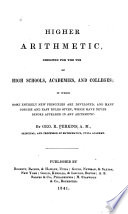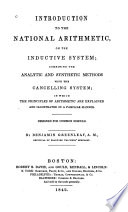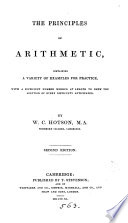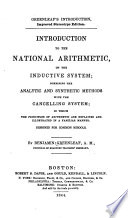 | George Roberts Perkins - Arithmetic - 1841 - 274 pages
...numbers to improper fractions, compound fractions to their simplest form. Then multiply each numerator by all the denominators, except its own, for a new numerator; and all the denominators together for a common denominator. It is obvious that this process will give the same... | |
 | John M'Nevin - Arithmetic - 1841 - 300 pages
...£, 24 + 20 = $$ = If reduced, from whence the following Rule is deduced: multiply each numerator by all the denominators, except its own, for a new numerator, and all the denominators together for a new denominator. Exampk.—Add 62^ « 37| « 19f By Reduction £ is... | |
 | Benjamin Greenleaf - Arithmetic - 1842 - 184 pages
...the respective numerators of the fractions, and their products will be the numerators required. Or, multiply each numerator into all the denominators except its own for a new numerator ; and all the denominators into each other for a common denominator. 2. Reduce £ and £ to a common denominator.... | |
 | Wales Christopher Hotson - 1842 - 306 pages
...fractions proposed, the required transformation will be effected if each numerator be multiplied by all the denominators, except its own, for a new numerator, and all the denominators together for a new denominator. Ex. To transform - - , — ; — , and , , , so as... | |
 | Charles Bathurst (schoolmaster.) - 1842 - 158 pages
...denominator. RULE. Reduce such of the fractions as require it to simple fractions. Multiply each numerator by all the denominators except its own for a new numerator, and all the denominators together for a common denominator. EXAMPLES. 1. Reduce f, £, 1£ and ^ to fractions... | |
 | Roswell Chamberlain Smith - Arithmetic - 1842 - 320 pages
...the numbers are not all single fractions reduce them to fuch first, then multiply each numerator by all the denominators except its own, for a new numerator ; and all the denominators together for a new denominator. 6. Reduce f , f , and 4 to a com. denominator. 105.... | |
 | Nathan Daboll - Arithmetic - 1843 - 254 pages
...to make a whole 1. Hence the common denominator is 12, and j oi' 12 is --1.,-. and £ of 12 is -fa. RULE I. Multiply each numerator into all the denominators except its own, for a new numerator ; then multiply all the denominators together for a common denominator, and place it under each new... | |
 | Roswell Chamberlain Smith - Arithmetic - 1843 - 320 pages
...the numbers are not all single fractions reduce them to such first, then multiply each numerator by all the denominators except its own, for a new numerator; and all the denominators together for a new denominator. 6. Reduce f, f, and 4 to a com. denominator. A 84... | |
 | James Bates Thomson - Algebra - 1844 - 272 pages
...measure, see Art. 195, a. 118. To reduce fractions of different denominators to a common denominator. Multiply each numerator into all the denominators except its own for a new numerator ; and all the denominators together, for a common denominator. 8. Reduce T, and -rt and — to a common denominator.... | |
 | Benjamin Greenleaf - Arithmetic - 1844 - 208 pages
...the respective numerators of the fractions, and their products will be the numerators required. Or, multiply each numerator into all the denominators except its own for a new numerator ; and all the denominators into each other for a common denominator. 2. Reduce J and £ to a common denominator.... | |
| |